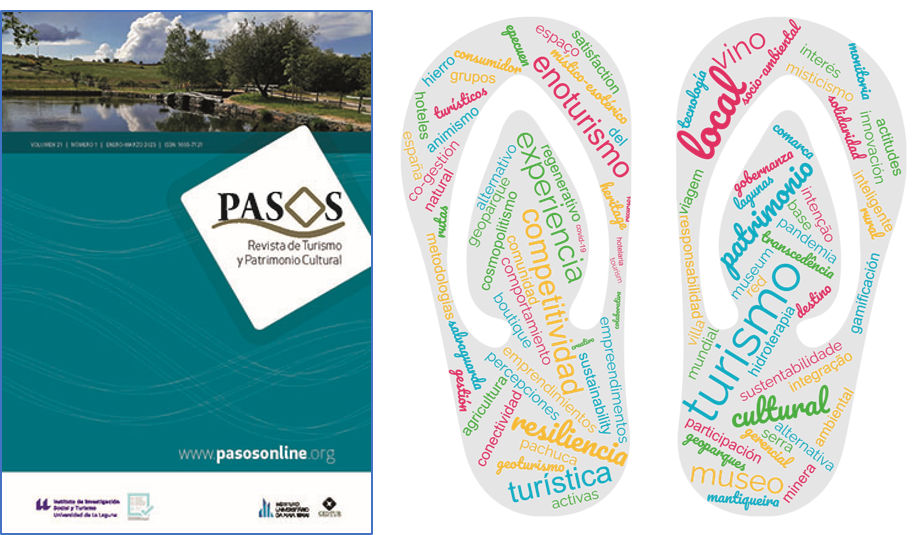Tourism as a tool for building environmental governance in the Comarca Minera Geopark
DOI:
https://doi.org/10.25145/j.pasos.2023.21.002Keywords:
environmental governance, Geopark, mining region, tourism, PachucaAbstract
In this article we analyse environmental governance, that is, the tools, mechanisms and programmes used by the government, civil society and an international organization (UNESCO) in the control, access to and use of natural resources in the area called “Geoparque Comarca Minera”, in the State of Hidalgo, Mexico. By conducting interviews and consulting official materials and a conceptual proposal on environmental governance, we analyse five dimensions (administration, coordination, resource management, social participation and sustainable development) of the relationship between the government, social organisations, local actors and the natural environment in a specific programme that seeks to generate territorial planning, conservation and change in the relationship between the government and the local population through a tourism project: the Archaeological Mining Route.
Downloads
Publication Facts
Reviewer profiles N/A
Author statements
- Academic society
- PASOS. Revista de Turismo y Patrimonio Cultural
- Publisher
- Instituto Universitario de Investigación Social y Turismo. Universidad de La Laguna (España) - Instituto Universitario da Maia ISMAI (Portugal)
References
Atotonilco el Grande (2017). Plan Municipal Atotonilco el Grande, México, Gobierno Municipal. Estado de Hidalgo: Municipio de Atotonilco. Recuperado de: http://planestataldedesarrollo.hidalgo.gob.mx/pdf/PMD/012-ATOTONILCO_EL_GRANDE/PMD_Atotonilco_el_Grande.pdf
Canto Chac M. (2008). Gobernanza y participación ciudadana en las políticas públicas frente al reto del desarrollo. Política y Cultura, 30, 9-37.
Carrión, F. (2010). Financiamiento de los centros históricos de América Latina y El Caribe. Ecuador: FLACSO.
De Castro F., Hogenboom B. y Baud M. (2015). Gobernanza ambiental en América Latina en la encrucijada. En F. De Castro Barbara y M. Baud (eds.), Gobernanza ambiental en América Latina (13- 38). Argentina: Clacso.
Gobierno de Hidalgo, (2017). Programa Estatal de Acción ante el Cambio Climático de Hidalgo (PEACCH). México: Gobierno del Estado de Hidalgo. Recuperado de: http://intranet.e-hidalgo.gob.mx/NormatecaE/Archivos/archivo6715.pdf
Gobierno de Hidalgo, (2021). 2ª Reforestación Geoparque Global Comarca Minera. Entrega de Reconocimientos “Geoparque Global Comarca Minera” a los presidentes Municipales del territorio. México: Gobierno del Estado de Hidalgo. Recuperado de: https://comunicacion-a.hidalgo.gob.mx/detalles/1628862763205
Gobierno del Estado de Hidalgo, (2021). Programa Sectorial de Desarrollo 2020- 2022. Política Pública Estatal de Educación y Cultura. México: Gobierno del Estado de Hidalgo. Recuperado de: file:///C:/Users/Usuario/Downloads/4.-Programa%20Sectorial%20de%20Educaci%C3%B3n%20y%20Cultura.pdf
Gobierno municipal de Pachuca de Soto (2020). Inventario de patrimonio edificado en la ciudad de Pachuca de Soto. Hidalgo: Dirección de Centro Histórico, Secretaría de Obras Públicas, Desarrollo Urbano, vivienda y Movilidad. Recuperado de: https://datos.pachuca.gob.mx/docs/inventario_patrimonio_inmuebles_2020.pdf?fbclid=IwAR3MSvEP18_G3XaGJyia2A4IEg6O6SSg2YIp3Midu4kxrLawfg5KLYuW4LI
Honorable ayuntamiento de Pachuca de Soto Hidalgo y Universidad Autónoma de Chapingo (2020). Programa de Ordenamiento Ecológico Local de Pachuca de Soto, Hidalgo. Hidalgo: Universidad Autónoma de Chapingo. Recuperado de: https://datos.pachuca.gob.mx/sipot/1/PDFS/Programa_de_Ordenamiento_Ecologico_Local_de_Pachuca_de_Soto.pdf
INEGI (2020). Panorama sociodemográfico de Hidalgo: Censo de Población y Vivienda 2020. México: Instituto Nacional de Estadística y Geografía. México.
La Ley Federal sobre Monumentos y Zonas Arqueológicas, Artísticas e Históricas. Diario Oficial de la Federación, 6 de mayo de 1972. Recuperado de: https://www.inah.gob.mx/Transparencia/Archivos/155_ley_fed_mntos_zon_arq.pdf
Lazcano, M. D., y Tellería, Y. (2019). Ruta Arqueológica Minera: La gestión integral del Antiguo Distrito Minero de Pachuca. Congreso de Investigación Aplicada al Turismo 2019, Instituto de Competitividad Turística, Secretaría de Turismo.
Montoya, T. (2019). La gestión del patrimonio intangible minero: perspectiva desde su formación en comunidades mineras. Minería y geología, 35(3), 358 -364.
Omitlán de Juárez (2019). Plan Municipal de Omitlán de Juárez. México: Gobierno Municipal. Recuperado de: http://planestataldedesarrollo.hidalgo.gob.mx/pdf/PMD/045-OMITLAN/PMD_Omitl%C3%A1n_de_Ju%C3%A1rez.pdf
Poch, J. y Canet, C. (2018). ¿Por qué un geoparque en la Comarca Minera de Hidalgo? una introducción al geopatrimonio y la geodiversidad. En: C. Carles. Guía de campo del Geoparque de la Comarca Minera (23-28). México: Universidad Nacional Autónoma de México.
UNAM, (2015). Dossier de candidatura proyecto geoparque Comarca Minera. México: UNAM.
UNAM, (2017). Acuerdo por el que se crea el seminario universitario de geopatrimonio y geoparques (SUgeo). Gaceta UNAM, No. 4893, p. 20 - 21. Recuperado de: http://www.abogadogeneral.unam.mx:6060/files/acuerdos/658-AcuerdoCreaSeminarioUniversitarioGeopatrimonioGeoparques_100817.pdf
UNESCO, (2021). “COMARCA MINERA, HIDALGO UNESCO GLOBAL GEOPARK (México)”. Recuperado de: https://en.unesco.org/global-geoparks/comarca-minera-hidalgo
Downloads
Published
How to Cite
Issue
Section
License
Copyright (c) 2022 mario alberto Velázquez García

This work is licensed under a Creative Commons Attribution-NonCommercial-NoDerivatives 4.0 International License.
I confirm that the work is original (of my/our authorship), and that it will not be submitted to other journals or publications until the final resolution of the review process in PASOS, RTPC.
I authorize the publication of my work by PASOS, PSTN of free and open access in any of the formats that I deem appropriate, for an indefinite period of time and as a non-remunerated collaboration.
Likewise, the author(s) understands that the published work may be linked or deposited on any server or included in other publications (republication), provided that the new place and/or new edition references the original publication and acknowledges the authorship and copyright ownership of PASOS RTPC publications.
Authors understand that a plagiarism-self-plagiarism check will be performed, and the article may be removed at any time from the editorial flow.










